Blog & Latest Updates
Fly Fishing Articles
Insects by Common Name


> > Holder Creek
I stopped along highway 18 east of Tiger Mountain and south of Fall City to collect some nymphs from this stream. It was simply a convenient spot to look for bugs (if scrambling down a steep, brushy, muddy slope counts as convenient). I have never heard of anyone fishing it. It seems too small and brushy to mess with, though it's large enough to probably hold small trout.
Closeup insects from Holder Creek
Claassenia sabulosa (Golden Stone) Stonefly Nymph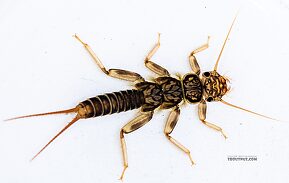 View 11 PicturesThis striking golden stonefly is the first of its species I've had the chance to photograph.
View 11 PicturesThis striking golden stonefly is the first of its species I've had the chance to photograph.
 View 11 PicturesThis striking golden stonefly is the first of its species I've had the chance to photograph.
View 11 PicturesThis striking golden stonefly is the first of its species I've had the chance to photograph.Collected April 12, 2021 from Holder Creek in Washington
Added to Troutnut.com by Troutnut on April 13, 2021
Added to Troutnut.com by Troutnut on April 13, 2021
Taenionema (Willowflies) Stonefly Nymph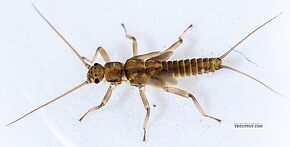 View 11 PicturesThis specimen was the only one of its kind in my kick net sample from this small creek. At first I thought it was Nemouridae, but it's not. Unfortunately, there is no species key available for Taenionema nymphs. Potential species found in Washington include nigripenne, oregonense, pacificum, and pallidum.
View 11 PicturesThis specimen was the only one of its kind in my kick net sample from this small creek. At first I thought it was Nemouridae, but it's not. Unfortunately, there is no species key available for Taenionema nymphs. Potential species found in Washington include nigripenne, oregonense, pacificum, and pallidum.
 View 11 PicturesThis specimen was the only one of its kind in my kick net sample from this small creek. At first I thought it was Nemouridae, but it's not. Unfortunately, there is no species key available for Taenionema nymphs. Potential species found in Washington include nigripenne, oregonense, pacificum, and pallidum.
View 11 PicturesThis specimen was the only one of its kind in my kick net sample from this small creek. At first I thought it was Nemouridae, but it's not. Unfortunately, there is no species key available for Taenionema nymphs. Potential species found in Washington include nigripenne, oregonense, pacificum, and pallidum.Collected April 12, 2021 from Holder Creek in Washington
Added to Troutnut.com by Troutnut on April 13, 2021
Added to Troutnut.com by Troutnut on April 13, 2021
Male Baetis bicaudatus (BWO) Mayfly Nymph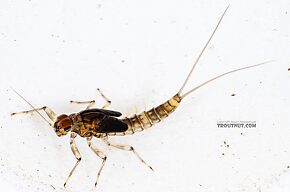 View 7 PicturesThis specimen was collected along with a female which was quite a bit larger, different in color, but otherwise seemed the same morphologically.
View 7 PicturesThis specimen was collected along with a female which was quite a bit larger, different in color, but otherwise seemed the same morphologically.
 View 7 PicturesThis specimen was collected along with a female which was quite a bit larger, different in color, but otherwise seemed the same morphologically.
View 7 PicturesThis specimen was collected along with a female which was quite a bit larger, different in color, but otherwise seemed the same morphologically.Collected April 12, 2021 from Holder Creek in Washington
Added to Troutnut.com by Troutnut on April 13, 2021
Added to Troutnut.com by Troutnut on April 13, 2021
Female Baetis bicaudatus (BWO) Mayfly Nymph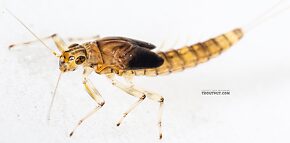 View 12 PicturesI collected this one along with a male that was quite a bit smaller but equally ready to emerge in mid April.
View 12 PicturesI collected this one along with a male that was quite a bit smaller but equally ready to emerge in mid April.
I spent (Spent: The wing position of many aquatic insects when they fall on the water after mating. The wings of both sides lay flat on the water. The word may be used to describe insects with their wings in that position, as well as the position itself.) quite a while on the identifications, because they really don't look very much like the Baetis bicaudatus nymph I caught last year in Idaho. However, the presence of hind wing pads (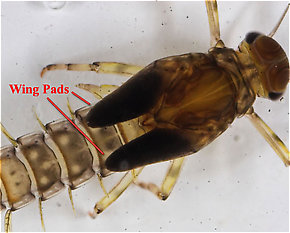 Wing pad: A protrusion from the thorax of an insect nymph which holds the developing wings. Black wing pads usually indicate that the nymph is nearly ready to emerge into an adult.) rules out Acentrella turbida, the lack of a fringe of long setae (Seta: Little hairs on insects.) on the tibiae (
Wing pad: A protrusion from the thorax of an insect nymph which holds the developing wings. Black wing pads usually indicate that the nymph is nearly ready to emerge into an adult.) rules out Acentrella turbida, the lack of a fringe of long setae (Seta: Little hairs on insects.) on the tibiae (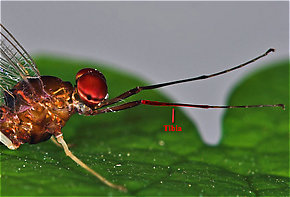 Tibia: A middle segments in the leg of an insect, located between the femur and the tarsus.) rules out Acentrella insignificans, range rules out Heterocloeon and Iswaeon, and the thumb-like projection on the labial palp (
Tibia: A middle segments in the leg of an insect, located between the femur and the tarsus.) rules out Acentrella insignificans, range rules out Heterocloeon and Iswaeon, and the thumb-like projection on the labial palp (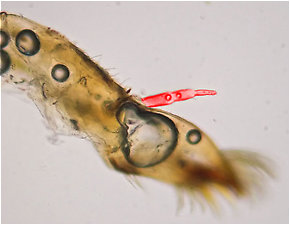 Palp: A long, thin, often segmented appendage which can protrude from certain insect mouth parts such as the maxillae. Also known as the < />palpus.) points to Baetis. Thus, Baetis bicaudatus is a fairly confident ID, and it's not too surprising that it looked different from my previous specimen because bicaudatus is thought to be a species complex with multiple types that haven't been fully sorted out yet.
Palp: A long, thin, often segmented appendage which can protrude from certain insect mouth parts such as the maxillae. Also known as the < />palpus.) points to Baetis. Thus, Baetis bicaudatus is a fairly confident ID, and it's not too surprising that it looked different from my previous specimen because bicaudatus is thought to be a species complex with multiple types that haven't been fully sorted out yet.
The microscope pictures for this specimen aren't from the same exact nymph, but a mixture of a few others of the same kind that I didn't mind dissecting.
 View 12 PicturesI collected this one along with a male that was quite a bit smaller but equally ready to emerge in mid April.
View 12 PicturesI collected this one along with a male that was quite a bit smaller but equally ready to emerge in mid April.I spent (Spent: The wing position of many aquatic insects when they fall on the water after mating. The wings of both sides lay flat on the water. The word may be used to describe insects with their wings in that position, as well as the position itself.) quite a while on the identifications, because they really don't look very much like the Baetis bicaudatus nymph I caught last year in Idaho. However, the presence of hind wing pads (

The wing pads on this final instar Baetidae mayfly nymph are extremely dark.

The tibia of this Isonychia bicolor mayfly spinner is highlighted in red.

The palp on the maxilla of an Ephemerella nymph (detached and photographed under a microscope) is highlighted in red here.
The microscope pictures for this specimen aren't from the same exact nymph, but a mixture of a few others of the same kind that I didn't mind dissecting.
Collected April 12, 2021 from Holder Creek in Washington
Added to Troutnut.com by Troutnut on April 13, 2021
Added to Troutnut.com by Troutnut on April 13, 2021
Start a Discussion of Holder Creek:
Top 10 Fly Hatches
Top Gift Shop Designs
Eat mayflies.
Top Insect Specimens
Miscellaneous Sites
Troutnut.com is copyright © 2004-2024 Jason
Neuswanger (email Jason). See my FAQ for information about use of my images.
 privacy policy
privacy policy
